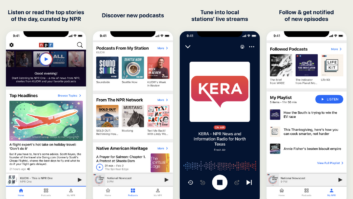LOS ANGELES�I�ve written quite a bit about streaming audio in Digital Radio Update over the last four years. Occasionally, I have pointed out articles about mobile communications�such as the cellular phone system�within the context of streaming audio to mobile listeners. I believe it�s time to concentrate more on this topic, since it most closely parallels over-the-air broadcasting. It also represents the technology that is most likely to precipitate the continual and gradual diminishing in the importance of O-T-A broadcasting.�
Here is the most important question I think broadcasters need to consider with respect to mobile listenership:
�������Will the increasing reliance on Wi-Fi networks and mobile networks eventually make over-the-air broadcasting obsolete?
That is not to say that broadcasting as we know it will become obsolete; just the means that we�re most familiar with. �Content� will always be generated and delivered in some fashion.�
In examining this over-arching question, we�ll look specifically at some of the smaller questions that, when answered, will really answer the question I posted above:
- � � � ��Will mobile networks supplant O-T-A broadcasting in vehicles?
- � � � ��Will the major mobile carriers really be able to support audio streaming to the extent that it can take the place of O-T-A transmission?
- � � � ��Will systems like NextRadio and RadioDNS help in maintaining the importance of O-T-A radio?
�
Just to be clear, I personally have a stake in this�since I spent nearly all of my working time on O-T-A systems. I�m going to do my best to be objective in examining the topic, but bear in mind that I�m by nature a skeptical person.�
Let�s first examine a piece fromrcrwireless.com, the subject of which is a plan by two researchers, funded by DARPA, that will show how to ”hack”�a connected car.� CharlieMiller and Chris Valasek said they will conduct demonstrations in August at the Black Hat and Defcon security conferences. �The researchers released a statement on a Black Hat website: �We will show the reality of car hacking by demonstrating exactly how a remote attack works against an unaltered, factory vehicle.��
According to the same article, the idea of remotely controlling a vehicle has raised concern within the auto industry and from government regulators. �Drivers have come to rely on these new technologies, but unfortunately the automakers haven�t done their part to protect us from cyberattacks or privacy invasions,� said U.S. Sen. Ed Markey (D-Mass.), earlier this year. �Even as we are more connected than ever in our cars and trucks, our technology systems and data security remain largely unprotected. We need to work with the industry and cybersecurity experts to establish clear rules of the road to ensure the safety and privacy of 21st-century American drivers.�
Could this represent more than just a temporary headwind for the ”connected” aspect of new cars? Probably not, I think; however, the day that ”road rage” turns in to ”road hacking” is just around the corner.�
Let�s shift gears a little bit here. Are you familiar with the term “Software Defined Network?”�From opennetworking.orgwe have the following definition:� �Software-Defined Networking is an emerging architecture that is dynamic, manageable, cost-effective, and adaptable, making it ideal for the high-bandwidth, dynamic nature of today’s applications. This architecture decouples the network control and forwarding functions enabling the network control to become directly programmable and the underlying infrastructure to be abstracted for applications and network services.�
Both Verizon and AT&T are in the process of changing their networks along these lines.� Again fromrcrwireless.com: �Verizon Communications publicly announced its software-defined networking plans…(saying) the move will allow the telecom giant to launch new services and applications more efficiently, as well as enable ‘rapid and flexible service delivery to Verizon�s customers.’�� One cannot fault VZW and ATT for turning their attention and capital on expanding their networks� capabilities. Whether or not their network upgrades will support more streaming capacity of course remains to be seen.












